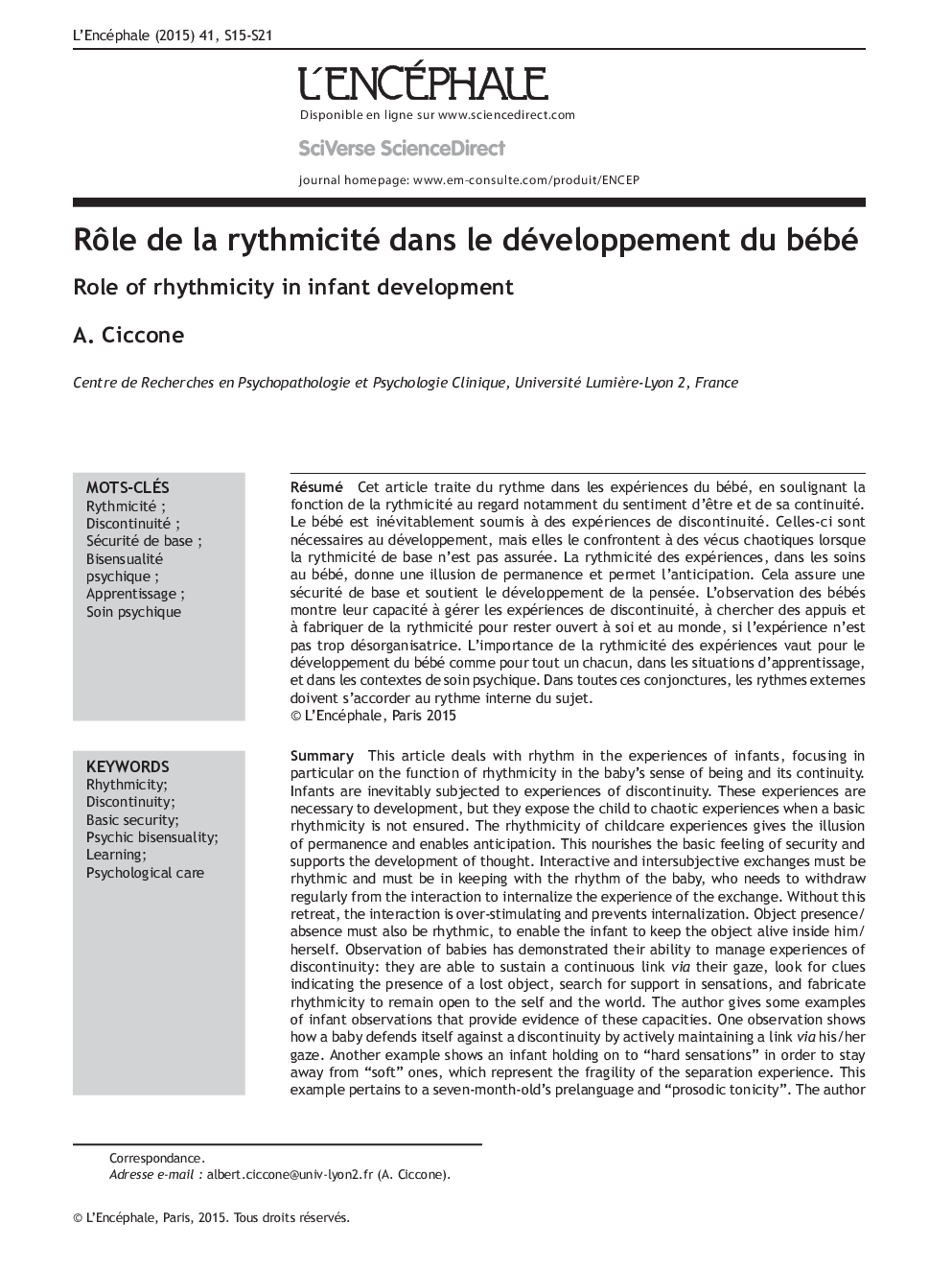| کد مقاله | کد نشریه | سال انتشار | مقاله انگلیسی | نسخه تمام متن |
|---|---|---|---|---|
| 4181583 | 1277130 | 2015 | 7 صفحه PDF | دانلود رایگان |
عنوان انگلیسی مقاله ISI
Rôle de la rythmicité dans le développement du bébé
دانلود مقاله + سفارش ترجمه
دانلود مقاله ISI انگلیسی
رایگان برای ایرانیان
کلمات کلیدی
موضوعات مرتبط
علوم پزشکی و سلامت
پزشکی و دندانپزشکی
روانپزشکی و بهداشت روانی
پیش نمایش صفحه اول مقاله

چکیده انگلیسی
This article deals with rhythm in the experiences of infants, focusing in particular on the function of rhythmicity in the baby's sense of being and its continuity. Infants are inevitably subjected to experiences of discontinuity. These experiences are necessary to development, but they expose the child to chaotic experiences when a basic rhythmicity is not ensured. The rhythmicity of childcare experiences gives the illusion of permanence and enables anticipation. This nourishes the basic feeling of security and supports the development of thought. Interactive and intersubjective exchanges must be rhythmic and must be in keeping with the rhythm of the baby, who needs to withdraw regularly from the interaction to internalize the experience of the exchange. Without this retreat, the interaction is over-stimulating and prevents internalization. Object presence/ absence must also be rhythmic, to enable the infant to keep the object alive inside him/ herself. Observation of babies has demonstrated their ability to manage experiences of discontinuity: they are able to sustain a continuous link via their gaze, look for clues indicating the presence of a lost object, search for support in sensations, and fabricate rhythmicity to remain open to the self and the world. The author gives some examples of infant observations that provide evidence of these capacities. One observation shows how a baby defends itself against a discontinuity by actively maintaining a link via his/her gaze. Another example shows an infant holding on to “hard sensations” in order to stay away from “soft” ones, which represent the fragility of the separation experience. This example pertains to a seven-month-old's prelanguage and “prosodic tonicity”. The author takes this opportunity to propose the notion of “psychic bisensuality” to describe these two sensation poles, which must be harmoniously articulated to guarantee an inner sense of security. Such repairs of discontinuity are only possible if the experience of discontinuity is not overly disorganizing. For instance, if an object is absent for more than a certain amount of time, it is no longer alive in the infant's mind and despair is inevitable. This prompts us to think carefully about the separation experiences we impose upon babies and their duration. Rhythms of security set in right from the beginning of early childhood, or even in utero. The author gives an example of recourse to inner rhythmicity in an 8 - or 9-month-old baby, which serves to ground the baby's sense of security. In infants, as in each one of us, rhythmicity organizes a foundation of permanence and bridges the gap created by separation. If leaning on sensations and creating neo-rhythms fails to repair the discontinuities, the baby will plunge into experiences of chaos and confusion, as seen, for example, in inconsolability. Even in this latter case, one can find a rhythmicity in the infant's crying, for example, as if the baby didn't want to be separated from the sorrow, a sort of paradoxical companion. Traces of all these primitive defenses can be found in the older child and in adult psychopathology. The importance of rhythmicity is stressed in relation to learning, which involves the experience of otherness and reality, and the rhythmic patterns of engagement and withdrawal support the integration process. The same holds true for the caretaking relationship: rhythmic involvement supports coming together, sharing, and understanding. In all of these situations, the parent, the teacher, the caregiver, must adapt to the child, the pupil, the patient; the external rhythms must fit the internal rhythm of the subject.
ناشر
Database: Elsevier - ScienceDirect (ساینس دایرکت)
Journal: L'Encéphale - Volume 41, Issue 4, Supplement 1, September 2015, Pages S15-S21
Journal: L'Encéphale - Volume 41, Issue 4, Supplement 1, September 2015, Pages S15-S21
نویسندگان
A. Ciccone,